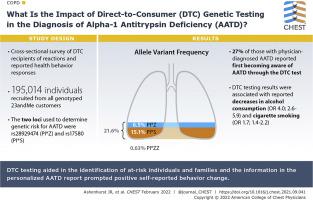Chest ( IF 9.6 ) Pub Date : 2021-10-14 , DOI: 10.1016/j.chest.2021.09.041 James R Ashenhurst 1 , Hoang Nhan 1 , Janie F Shelton 1 , Shirley Wu 1 , Joyce Y Tung 1 , Sarah L Elson 1 , James K Stoller 2 , 1

|
Background
Alpha-1 antitrypsin deficiency (AATD) is an autosomal co-dominant condition that predisposes to emphysema, cirrhosis, panniculitis, and vasculitis. Underrecognition has prompted efforts to enhance early detection and testing of at-risk individuals. Direct-to-consumer (DTC) genetic testing represents an additional method of detection.
Research Question
The study addressed three questions: (1) Does a DTC testing service identify previously undetected individuals with AATD? (2) What was the interval between initial AATD-related symptoms and initial diagnosis of AATD in such individuals? and (3) What was the behavioral impact of learning about a new diagnosis of AATD through a DTC test?
Study Design and Methods
In this cross-sectional study, 195,014 individuals responded to a survey within the 23andMe, Inc. research platform.
Results
Among 195,014 study participants, the allele frequency for the PI∗S and PI∗Z AATD variants was 21.6% (6.5% for PI∗Z and 15.1% for PI∗S); 0.63% were PI∗ZZ, half of whom reported having a physician confirm the diagnosis. Approximately 27% of those with physician-diagnosed AATD reported first becoming aware of AATD through the DTC test. Among those newly aware participants, the diagnostic delay interval was 22.3 years. Participants frequently shared their DTC test results with health care providers (HCPs) and the reported impact of learning a diagnosis of AATD was high. For example, 51.1% of PI∗ZZ individuals shared their DTC result with an HCP. The OR for PI∗ZZ smokers to report smoking reduction as a result of receiving the DTC result was 1.7 (95% CI = 1.4-2.2) compared with those without a Z allele and for reduced alcohol consumption this was 4.0 (95% CI = 2.6-5.9).
Interpretation
In this largest available report on DTC testing for AATD, this test, in combination with clinical follow-up, can help to identify previously undiagnosed AATD patients. Moreover, receipt of the DTC AATD report was associated with positive behavior change, especially among those with risk variants.
中文翻译:

个性化遗传风险报告直接面向消费者的接受者中 Alpha-1 抗胰蛋白酶缺乏症的患病率、自我报告的行为改变和医疗保健参与
背景
Alpha-1 抗胰蛋白酶缺乏症 (AATD) 是一种常染色体显性遗传病,易患肺气肿、肝硬化、脂膜炎和血管炎。认识不足促使人们努力加强对高危人群的早期发现和测试。直接面向消费者 (DTC) 的基因检测是另一种检测方法。
研究问题
该研究解决了三个问题:(1) DTC 测试服务是否可以识别以前未被发现的 AATD 患者?(2) 在这些个体中,初始 AATD 相关症状与 AATD 初始诊断之间的间隔是多长时间?(3) 通过 DTC 测试了解 AATD 的新诊断对行为有何影响?
研究设计和方法
在这项横断面研究中,195,014 人对 23andMe, Inc. 研究平台内的一项调查做出了回应。
结果
在 195,014 名研究参与者中,PI*S 和 PI*Z AATD 变体的等位基因频率为 21.6%(PI*Z 为 6.5%,PI*S 为 15.1%);0.63% 是 PI*ZZ,其中一半报告有医生确认诊断。大约 27% 的医生诊断为 AATD 的人报告说他们是通过 DTC 测试首次意识到 AATD 的。在那些新认识的参与者中,诊断延迟间隔为 22.3 年。参与者经常与医疗保健提供者 (HCP) 分享他们的 DTC 测试结果,据报道学习 AATD 诊断的影响很大。例如,51.1% 的 PI*ZZ 个人与 HCP 分享了他们的 DTC 结果。与没有 Z 等位基因的吸烟者相比,PI*ZZ 吸烟者因收到 DTC 结果而报告吸烟减少的 OR 为 1.7(95% CI = 1.4-2.2),而对于减少饮酒而言,OR 为 4。
解释
在这份关于 AATD 的 DTC 测试的最大可用报告中,该测试与临床随访相结合,可以帮助识别以前未确诊的 AATD 患者。此外,收到 DTC AATD 报告与积极的行为改变有关,尤其是那些有风险变异的人。



























 京公网安备 11010802027423号
京公网安备 11010802027423号